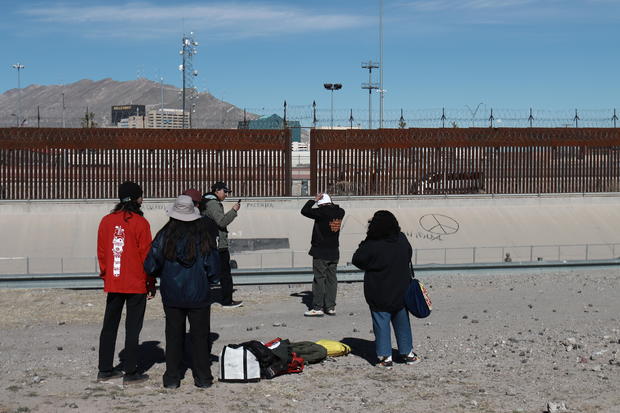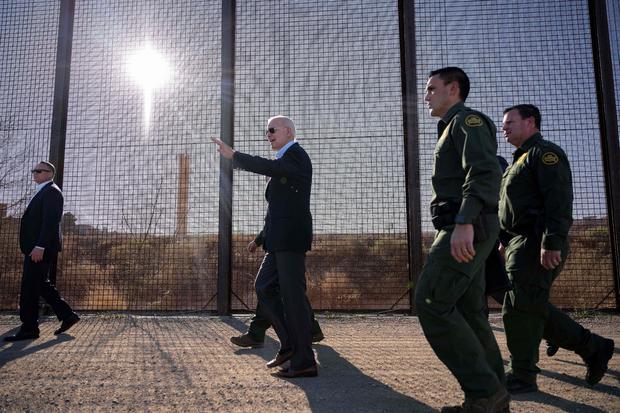Unlawful entries along U.S.-Mexico border plummeted in January after expansion of migrant expulsions
The number of migrants apprehended by U.S. Border Patrol after illegally crossing the southern border dropped by roughly 40% in January, when the Biden administration announced a revamped strategy to discourage unlawful crossings, according to preliminary government data obtained by CBS News.
Border Patrol agents recorded approximately 130,000 apprehensions of migrants who entered the U.S. between official ports of entry along the border with Mexico, compared to the near-record 221,000 apprehensions in December, the internal preliminary figures show. The number of Border Patrol apprehensions in November and October totaled 207,396 and 204,874, respectively.
The statistics indicate that January saw the lowest levels of illegal migration along the U.S.-Mexico border since President Biden’s first full month in office in February 2021. The figures do not include migrants and asylum-seekers processed at official border crossings.
Senior U.S. officials said the sharp drop in illegal entries last month stemmed from the Biden administration’s expansion of a strategy it launched last year to reduce the number of Venezuelans entering U.S. border custody.
In early January, the administration announced it would use a pandemic-related authority known as Title 42 to swiftly expel Cubans, Nicaraguans, Haitians and Venezuelans to Mexico without allowing them to seek asylum if they attempted to cross into the U.S. without legal permission.
Before the announcement, Mexico generally only accepted Title 42 returns of its citizens and migrants from Guatemala, Honduras, El Salvador and, after October 2022, Venezuela. The repressive governments in Cuba, Nicaragua and Venezuela, which are sanctioned by the U.S., have for their part severely limited or rejected U.S. deportations of their citizens.
Officials simultaneously announced that the U.S. would allow up to 30,000 migrants from these four countries to fly into the U.S. on a monthly basis if Americans agreed to sponsor their arrival. The administration is also allowing a limited number of migrants in northern Mexico to request a humanitarian exemption to Title 42 at ports of entry through a mobile app.
Christian Torres/Anadolu Agency via Getty Images
While migrant arrivals along the U.S. southern border have historically dipped in January due to a holiday season lull and colder temperatures, the drop over the past few weeks has been most pronounced among migrants from countries whose citizens are subject to the new procedures, government statistics show.
The daily average of Cubans, Nicaraguans, Haitians and Venezuelans crossing the southern border illegally has dropped below 200, down over 90% from a peak of 3,367 in December, according to the government data.
It’s unclear, however, whether the downward trend will continue in the coming months. The Biden administration has itself conceded that the policies announced last month are stopgap measures prompted by Congress’ failure to reform U.S. immigration laws since the 1990s.
The strategy’s deterrence component relies on a pandemic order the Biden administration tried to end last spring and that Centers for Disease Control and Prevention (CDC) officials have said they no longer can justify on public health grounds.
The CDC’s move to terminate Title 42 in May 2022 was halted after Republican state officials convinced a federal judge in Louisiana to block the termination on technical grounds. Title 42 was again set to end in late December, but the Supreme Court, at the request of the Republican-led states, suspended a lower court ruling that had declared the policy illegal.
Those cases could be rendered moot on May 11, when the Biden administration is expected to terminate the national public health emergency over COVID-19. The CDC said in its Title 42 order that the expulsions would be halted if the health emergency was lifted.
On Wednesday, a bipartisan group of senators reintroduced a bill that would prolong Title 42 for at least two months after the emergency declaration expires and require the Department of Homeland Security to submit a plan to Congress on how it will manage migration after the expulsions are halted.
Biden administration officials said they have been preparing for Title 42’s end for the past year, including by expanding a process known as expedited removal that allows U.S. border officials to rapidly deport migrants who don’t ask for asylum or who fail to establish credible fear of persecution.
The administration is also planning to publish a regulation that would generally disqualify migrants from asylum if they do not ask for protection in third countries on their way to the U.S. Those subject to the policy could be deported without a court hearing.
Mr. Biden’s strategy is also under legal jeopardy. Twenty states led by Texas Attorney General Ken Paxton filed a lawsuit last month seeking to halt the sponsorship program for migrants from Cuba, Nicaragua, Haiti and Venezuela. The states argued the policy is an illegal expansion of the parole authority, the law the Biden administration is using to allow those arriving under the program to live and work legally in the U.S. on a temporary basis.
The Biden administration has said the lawsuit, if successful, would fuel more illegal border crossings since Mexico made its decision to accept migrants returned by the U.S. contingent on the U.S. fulfilling its pledge to take in 30,000 migrants each month via the sponsorship program.
“These expanded border enforcement measures are working,” Secretary of Homeland Security Alejandro Mayorkas said last week. “It is incomprehensible that some states who stand to benefit from these highly effective enforcement measures are seeking to block them and cause more irregular migration at our southern border.”
JIM WATSON/AFP via Getty Images
In addition to the constant criticism from Republican lawmakers who have accused Mr. Biden of not fully enforcing U.S. immigration laws, his administration has recently faced pushback from some Democratic allies angry with the policies that limit access to the asylum system.
The proposal to disqualify migrants from asylum in particular has garnered strong opposition from progressive advocates and dozens of Democrats in Congress, who have noted the policy is similar to a regulation the Trump administration enacted in 2019 before it was struck down in federal court.
Andrea Flores, who was a National Security Council official until late 2021, criticized the reliance on Trump-era measures to manage migration.
“Any border management policy that relies on a short-term public health authority is not a sustainable solution to mass migration,” said Flores, who now serves as counsel to Democratic Sen. Bob Menendez of New Jersey. “A single weather or political event could happen next month, Title 42 could disappear, and the whole situation could change in an instant.”
But the Biden administration has argued the measures are needed to address the unprecedented migration crisis the U.S. government and local communities along the southern border have faced over the past year.
In fiscal year 2022, federal officials along the southern border stopped migrants over 2.3 million times, a record high. While Title 42 was used to carry out over 1 million expulsions during that period, hundreds of thousands of migrants were allowed to stay in the country and submit asylum requests before an overwhelmed court system.
The humanitarian crisis along the U.S. southern border is part of a mass displacement event in the Western Hemisphere that has seen millions of people uprooted from their homes by poverty, hunger, violence and authoritarian rule.
Over the past year, hundreds of thousands of Cubans, Nicaraguans and Venezuelans have journeyed to the U.S. border, fleeing economic instability and political repression in their homelands. Thousands of Haitians have also sought to reach the U.S. in hopes of escaping the political turmoil and gang violence plaguing the destitute Caribbean nation.
For all the latest Automobiles News Click Here
For the latest news and updates, follow us on Google News.




